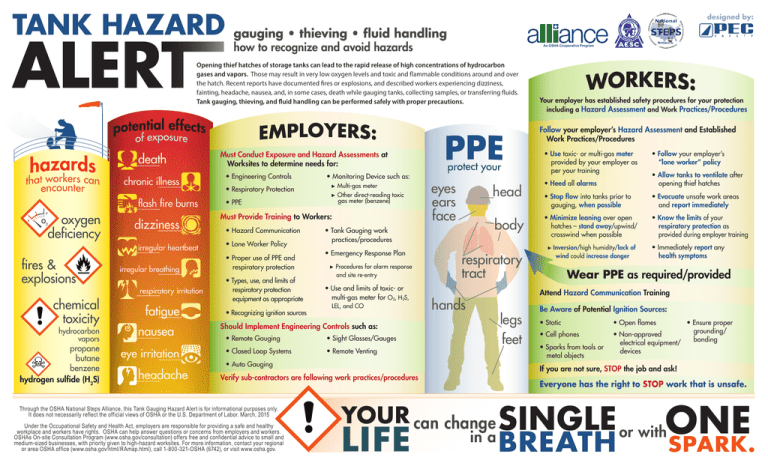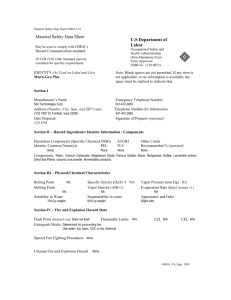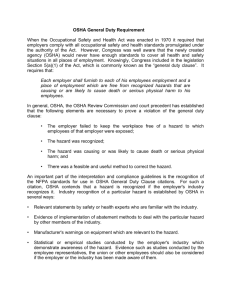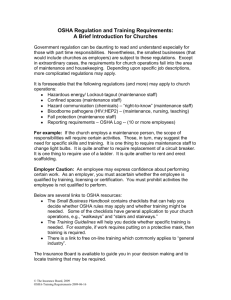TANK HAZARD
advertisement

TANK HAZARD designed by: gauging • thieving • fluid handling how to recognize and avoid hazards An OSHA Cooperative Program Opening thief hatches of storage tanks can lead to the rapid release of high concentrations of hydrocarbon gases and vapors. Those may result in very low oxygen levels and toxic and flammable conditions around and over the hatch. Recent reports have documented fires or explosions, and described workers experiencing dizziness, fainting, headache, nausea, and, in some cases, death while gauging tanks, collecting samples, or transferring fluids. Tank gauging, thieving, and fluid handling can be performed safely with proper precautions. Your employer has established safety procedures for your protection including a Hazard Assessment and Work Practices/Procedures Follow your employer’s Hazard Assessment and Established Work Practices/Procedures death chronic illness flash fire burns oxygen deficiency O2 dizziness irregular heartbeat fires & explosions chemical toxicity hydrocarbon vapors propane butane benzene hydrogen sulfide (H2S) irregular breathing respiratory irritation fatigue nausea eye irritation headache • Use toxic- or multi-gas meter provided by your employer as per your training Must Conduct Exposure and Hazard Assessments at Worksites to determine needs for: • Engineering Controls • Respiratory Protection • PPE • Monitoring Device such as: Multi-gas meter ► Other direct-reading toxic gas meter (benzene) ► Must Provide Training to Workers: • Hazard Communication • Lone Worker Policy • Proper use of PPE and respiratory protection • Types, use, and limits of respiratory protection equipment as appropriate • Recognizing ignition sources eyes ears face head body • Tank Gauging work practices/procedures • Emergency Response Plan ► Procedures for alarm response and site re-entry • Use and limits of toxic- or multi-gas meter for O2, H2S, LEL, and CO respiratory tract • Sight Glasses/Gauges • Closed Loop Systems • Remote Venting hands legs feet • Auto Gauging Under the Occupational Safety and Health Act, employers are responsible for providing a safe and healthy workplace and workers have rights. OSHA can help answer questions or concerns from employers and workers. OSHAs On-site Consultation Program (www.osha.gov/consultation) offers free and confidential advice to small and medium-sized businesses, with priority given to high-hazard worksites. For more information, contact your regional or area OSHA office (www.osha.gov/html/RAmap.html), call 1-800-321-OSHA (6742), or visit www.osha.gov. • Allow tanks to ventilate after opening thief hatches • Stop flow into tanks prior to gauging, when possible • Evacuate unsafe work areas and report immediately • Minimize leaning over open hatches – stand away/upwind/ crosswind when possible • Know the limits of your respiratory protection as provided during employer training ► Inversion/high humidity/lack of wind could increase danger Wear PPE as required/provided Be Aware of Potential Ignition Sources: • Static • Cell phones • Sparks from tools or metal objects • Open flames • Ensure proper grounding/ • Non-approved bonding electrical equipment/ devices Everyone has the right to STOP work that is unsafe. YOUR can change SINGLE LIFE • Immediately report any health symptoms If you are not sure, STOP the job and ask! Verify sub-contractors are following work practices/procedures Through the OSHA National Steps Alliance, this Tank Gauging Hazard Alert is for informational purposes only. It does not necessarily reflect the official views of OSHA or the U.S. Department of Labor. March, 2015 • Heed all alarms Attend Hazard Communication Training Should Implement Engineering Controls such as: • Remote Gauging • Follow your employer’s “lone worker” policy in a BREATH ONE SPARK. or with



